Analysis on the synergistic effect of sustainable development of coal industry under 1.5°C scenario
SHI Yue-Yo,SUN Jin,WU Li-Xin
a Research Institute of Strategic Planning,China Coal Research Institute,Beijing 100013,China
b Sinopec Research Institute of Petroleum Engineering,Beijing 100101,China
Abstract Based on the coal demand under the 1.5°Cscenario,the amount of coal production in China was estimated in this study.According to the mutual relationship between the factors infl uencing coal production,an econometric model was constructed based on simultaneous equations,and the synergistic effect of each factor on the coal industry was estimated under the 1.5°Cscenario.Then,predictions were respectively made in the five aspects:coal production,coal science and technology progress,employment number,safe production level,and occupational health level,in different scenarios from 2016 to 2050.The results showed that before 2040,the comprehensive negative effect of the 1.5°Csituation is more than or equals to the positive effect.The 1.5°C scenario has the biggest negative impact on employment,whose solution should be the focus.By 2050,the positive effects of the 1.5°Cscenario exceed the negative effect because of the enhancement in technical level and in the attention given to the whole production.Safety is improved,and health defects decline and the most obvious positive effect is on the ecological environment.The decrease of coal production will reduce the ecological environmental damage and signifi cantly improve the ecological environment.In general,the prediction of 1.5°C scenario promotes the increase of scientifi c production capacity and promotes the orderly development of coal.It has strengthened the safety and health protection degree,made the coal industry more efficient and competitive,and avoided or reduced the impact of coal development on the ecological environment and achieved environmental friendliness.However,the 1.5°C situation also increases the employment pressure of the society,which affects the economic development of the major coal producing areas,but the situation can be overcome through the transformation and upgrading of the region.Finally,the impacts of various factors under the 1.5°C scenario were evaluated through a unifi ed comparison of the synergistic effect monetization using the cost and payment willingness methods.Based on the research results,suggestions on the regulation of coal production were proposed relating to resettlement of workers,protection of the ecological environment,and improvement of workers'health.
Keywords:1.5°C scenario;Synergistic effect;Effect monetization
1.Introduction
On November 30,2015,the Paris Agreement wassigned by national negotiators from 195 nations in the 21st United Nations Climate Change Conference,whereby all participants agreed to strengthen the global response to climate change threat,maintain theglobal averagetemperaturerisewell below 2°Cabovepre-industrial levels,and pursueeffortsfor a1.5°C limit,as well as to achieve a total global greenhouse gas(GHG)emissions peak within a considerable short term and a net zero GHGs emission in the second half of the 21st century(Zhang,2016a).
As the basic sector of the national economy,the coal industry has done a lot of research on controlling the total amount of coal,but there is no literature about the prediction of coal production and consumption under the 1.5°Cscenario.With the rapid development of China's economy,the demand for energy has increased dramatically.More studies on the prediction of the total coal demand have been carried out.For example,Zhang et al.(2014)used the trend regression analysis,BPfiltering,and the seasonal adjustment method to study the changing pattern of the long-term and short-term coal demand.He also adopted the regression model to analyze the specifi c factors that affect the change of coal demand.The study providean important support for thecoal industry supply chain security and contingency reserve.Theprediction of total coal demand providesan important basisfor the regulation and control of total coal quantity.However,in literature,there are inadequate comprehensive studies on the infl uence of the total amount of coal consumption on all aspects of economic and social developments.Most works of literature only discussthe infl uence of coal consumption on certain aspects of social and economic development,such as the economy and ecological environment.For example,Lin(2001)developed a cointegration equation to study the coal demand in China'slong-term equilibrium relations and estimate the coal demand in China's long-term income elasticity and price elasticity,structure elasticity,and transportation cost elasticity.Meanwhile,they also predicted the long-term coal demand and analyzed its impact on the environment(mainly the emission of sulfur dioxide,carbon dioxide,and nitrogen oxide),coal supply,and coal prices.Li et al.(2013)studied the infl uence of coal consumption on the regional economic performance based on the input and output panel data of 13 coal-consuming provinces in 1995-2010,and empirically estimated the environmental total factor productivity index of these regions using the Malmquist index approach.Bai et al.(2012)analyzed the impacts of coal mining on the water resource,land resource,and ecological environment of Yulin,based on an investigation of the ecological environment in the coal-mining area of Yulin.Considering the 1.5°C scenario,changes in coal production and consumption would affect many aspects,which would in turn affect coal production and consumption.
Given that the economic phenomenon is complex,a single equation cannot adequately depict the relationship between economic variables,as it does not consider the mutual relationship between thevariables.These single equations need to be combined to form a simultaneous equation model,which has been widely used in empirical research.Wang and Guo(2009)established a production function of endogenous growth and built a simultaneous equation model to study the relationship between fi scal decentralization and economic growth,where the fiscal decentralization was considered on basis of infl uencing the human and public capitals that affect economic growth.Li and Yang(2015)and Wang(2012)each constructed a simultaneous equation model of product price,capital structure,and portfolio risk by expanding the classical option pricing theory model.Kong and Gao(2012)investigated the relationship and the endogenous basis between the housing price and trading volume using the interprovincial panel data.They used simultaneous equations and three-stage least squares method to discover a positive correlation lag between housing price and trading volume,with the housing price leading.
In addition to offering the production model of the coal industry,this study analyzes the relationship between various factorsand coal production;theinfl uencesof variousfactorsin the 1.5°Cscenario areestimated,and a simultaneousequation model is further constructed covering factors of production and safety,environment,health,employment,and other coal industry interaction mechanisms.
2.Data and methods
In this study,the previous research result from the Energy Research Institute of the National Development and Reform Commission on the coal demand under the 1.5°C scenario was applied,and the relevant data referenced from the Energy Production and Consumption Revolution Strategy(2016-2030)and the major project by the Chinese Academy of Engineering,Promote Energy Production and Consumption Revolution Strategic Studies(Phase I)were used as the base line scenario(as shown in Table 1).The correlations of the coal production factors were calculated,upon which the economic measurement model of the simultaneous equation was constructed.The 1.5°C scenario coal industry synergistic effect was estimated based on monetization of cost and payment-intention approaches.
2.1.Variables selection
Coal production is a complex system composed of various elements.When these factors are gathered,in addition to the“contract”constraint,coal production is also infl uenced and dominated by the internal and external environments.We can view the coal enterprise as an individual entity,because it is the resource producer,and its actions are more restricted by factors such as natural resources(Zhang et al.,2008).Dong and Shi(2009)believe that the output of coal enterprises is affected by four factors,natural resource,capital,labor,and science and technology factors.Natural resource factors are composed of the coal resource,land resource,associated mineral resource,and groundwater resource.Thecoal resource is composed of coal reserve,coal categories,coal occurrence condition,and geological environmental factors.The capital factors consist of two levels,the fi nancial capital and materialized capital.The fi nancial capital comprises the internal investment and external investment capitals,and the materialized capital comprises mine equipment,mining right,exploration right,basic well lanes,post-investment equity,and other materialized capitals.The labor factors are composed of mental work and manual labor,where mental work comprises labor force quantity,labor cost,labor quality,and labor culture adaptability,and manual labor comprises labor force quantity,labor cost,labor quality,and labor culture adaptability.The technology factors are composed of the science and technology levels,which comprise the technology of new product development,miner environmental protection technology,staff training,safety technology inspection control,coal washing,and processing technology,equipment update mechanization automation,rock mechanics for stope design and mining process,and coal resource exploration and geological elements.These factors fundamentally determine the coal production quantity of coal enterprises.In turn,the production quantity would have an impact on these factors.Coal production and consumption are also closely linked,and coal exports and imports also affect coal production and consumption(Dong,2008).

Table 1 Total coal consumption in different scenarios(unit:Gtce).
Lin and Li(2015)showed that the coal production quantity is directly related to many factors,including safety of coal mines,ecological environment,science and technology level,and human resource.Specifically,the rate of coal mine accidents dependson the production of coal mines,technical level of devices,number of employees,geological conditions of coal mines,environmental condition,and intensity of the local government control.The relationship between the ecological environment and coal industry dependson the coal production,technical level of equipment,and governance.The number of occupational diseases in the coal industry depends on the coal mine output,technical level of equipment,number of employees,and governmental departments'control.The technical progress level of the coal industry is positively correlated with per unit of coal yield.The employment level of the coal industry depends on the current production,fi xed assets(capital input),and technical level,as well as the number of national labor force.The capital of the coal industry is also an important factor affecting coal production.The capital formation is composed of previous capital accumulation and new investment input.Nonetheless,input depends on the profit level,because the profit level depends on factors such as consumption and prices.Therefore,this research group concludes that coal production quantity should be calculated according to coal consumption,coal import,and coal inventory from 2016 to 2050,and then the mutual infl uence between thesevariablesshould beexplored and unified in aframework.They should be analyzed through simultaneous equations,and each factor is then represented with its direct relationship to the coal production.
With reference to the relevant literature,combined with the existing data,the “coal mining mechanization degree”is used to indicate the level of technological progress in the coal industry; “coal accident deaths”represents the coal industry safety level;time dummy variable represents the government's regulation of the coal industry;“coal mining and washing industry fixed assets”represents the capital level of the coal industry.These variables are selected into a simultaneous equationsmodel.Theempirical analysisof thedataisfrom the China Economic Database(CEIC),Compilation of China Coal Industry Statistics,and National Bureau of Statistics website.Interpolation is carried out to make up for some of the missing data(Table 2).
2.2.Econometric model
The single equation model is not effi cient enough to describe the relationship between economic variables.Therefore,we use single equations to construct simultaneous equations model,which can better describe the interactional mechanism of the variables.
Since there are lagsof variables behind coal production,we use the distributed lag model to characterize their relationship as Eq.(1).

In Eq.(1),Y represents the explained variables,X represents explanatory variable,t represents time,i represents lag periods,βirepresents the effect of X on Y under lag periods,α represents constant,andμtrepresents the random disturbance term.The lag periods are determined by the situation.According to the chosen variables,we can derive the model of econometric simultaneous equations as Eqs.(2)-(8).


Table 2 The selection and meaning of variables in simultaneous equations model.
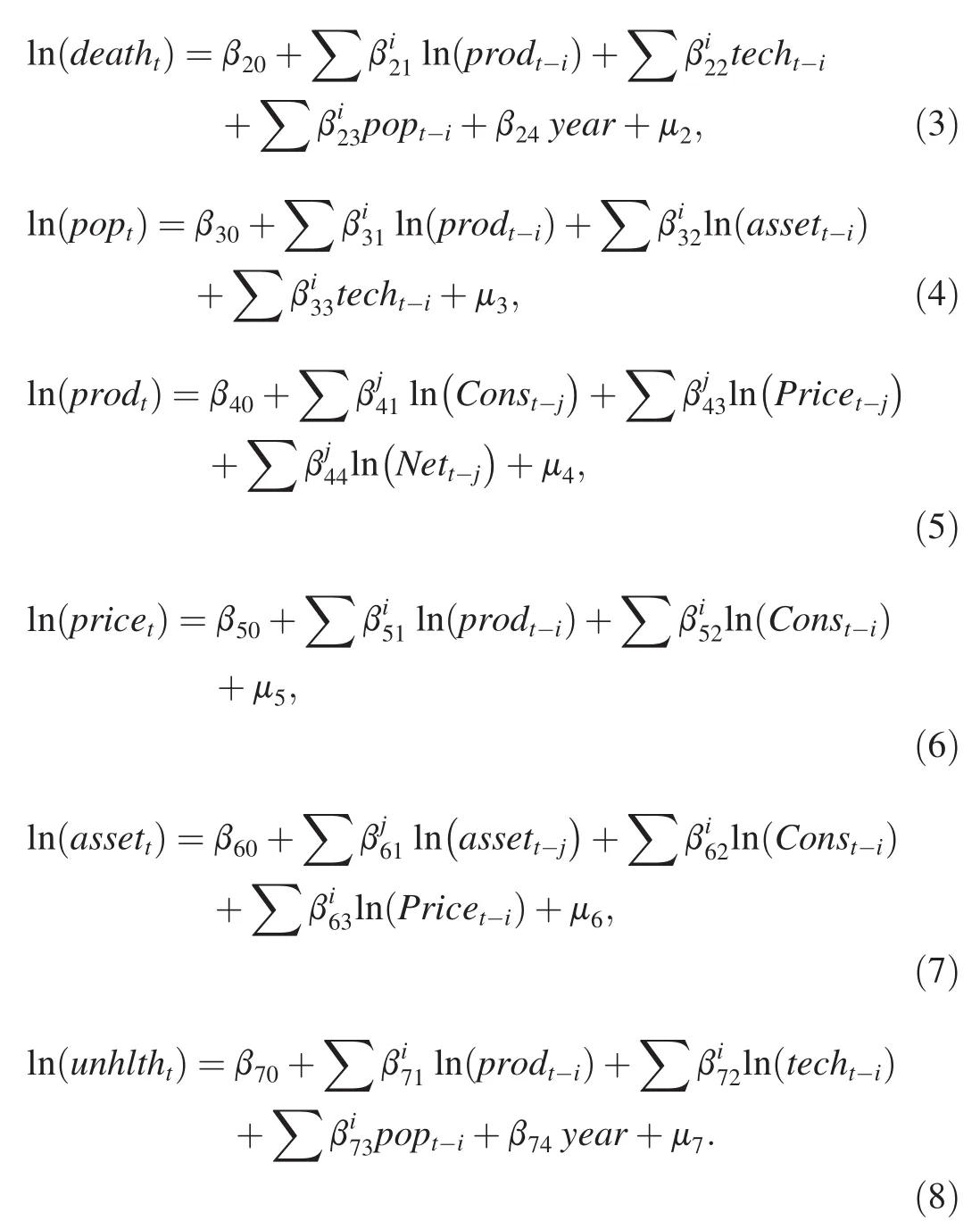
ln(·)isthe natural logarithm of thevariables.While cons and year are exogenous variables,tech,pop,death,prod,price,asset,and unhlth are endogenous variables.Furthermore,j is an integer≥1,while i is an integer≥0.
3.Simulation results of different scenarios
Using the three-stage least squares method to estimate the simultaneousequation model,themodel resultswere obtained after removing the less signifi cant variables.In the 1.5°C scenario,the predicted value of each factor variable can be deduced by the estimated simultaneous equations model.In addition,weneed to consider theimpact of the1.5°Cscenario on the ecological environment and other factors.However,because of the lack of these data indicators,they are not included in the model.In this section,the prediction of the following indicators is given in the baseline and 1.5°C scenarios.
3.1.The evaluation of the variables for different scenarios
3.1.1.Coal production
In order to facilitate the subsequent conversion of standard coal to tons of coal.Under the baseline scenario,the coal production declines from 3.45 Gt(2.46 Gtce)in 2016 to 2.72 Gt(1.94 Gtce)in 2050,while under the1.5°Cscenario,it declines more quickly from 3.45 Gt(2.46 Gtce)in 2016 to 0.87 Gt(0.865Gtce)in 2050(Fig.1).
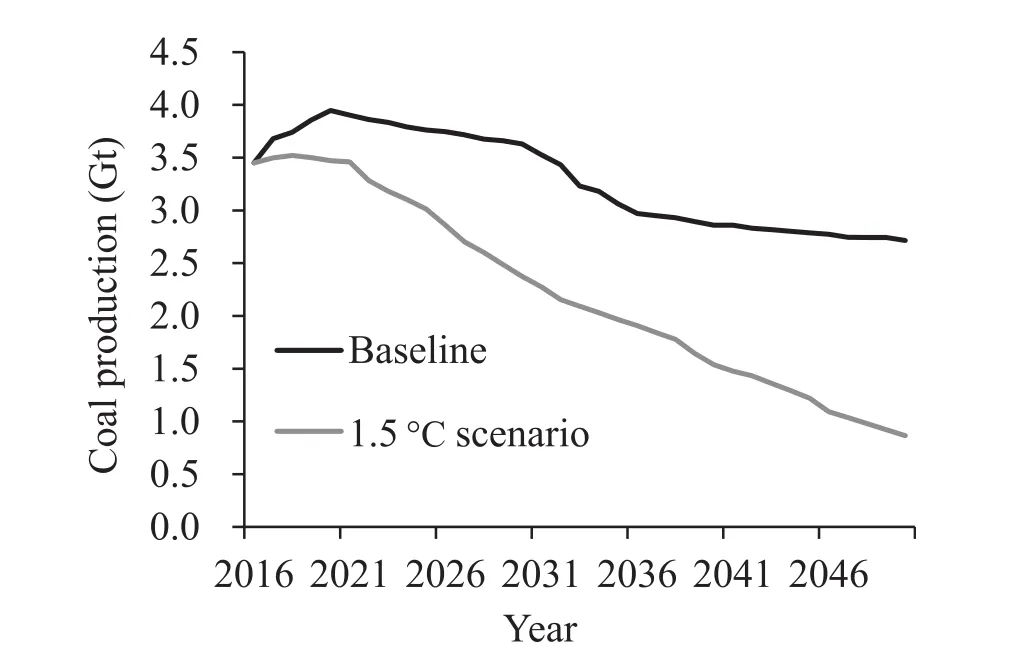
Fig.1.Coal production under two scenarios in 2016-2050.
3.1.2.Improvement of thecoal scienceand technology level
Under the baseline scenario,the national coal-mining mechanization degree reaches 85%in 2020 and 100%in 2043,while under the1.5°Cscenario,it reaches100%in 2033(Fig.2).
3.1.3.The number of employments
Under the baseline scenario,the number of employmentsof the coal industry declinesfrom 4 million in 2016 to 1.1 million in 2050,with a decrease of 2.9 million.Under the 1.5°C scenario,the number of employments of the coal industry declinesfrom 4 million in 2016 to 0.27 million in 2050,with a decrease of 3.63 million(Fig.3).
3.1.4.The safety level in production
Under the baseline scenario,the number of deaths in the coal industry is 212 in 2050,and the death rate per million tons of coal production declines from 0.156 in 2016 to 0.078 in 2050,while under the 1.5°C scenario,the number of death of the coal industry is 23 in 2050,and the death rate declines from 0.156 in 2016 to 0.003 in 2050(Fig.4).
3.1.5.The health level of employees
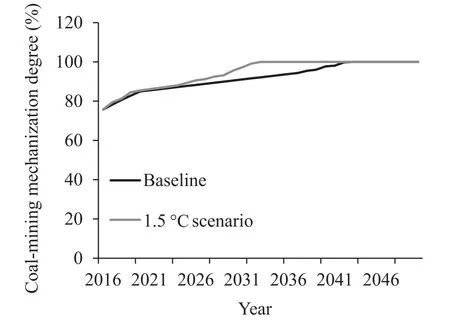
Fig.2.The coal-mining mechanization degree under two scenarios in 2016-2050.
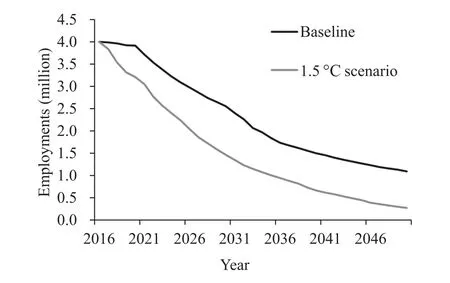
Fig.3.Thenumber of employment in thecoal industry under thetwo scenarios in 2016-2050.
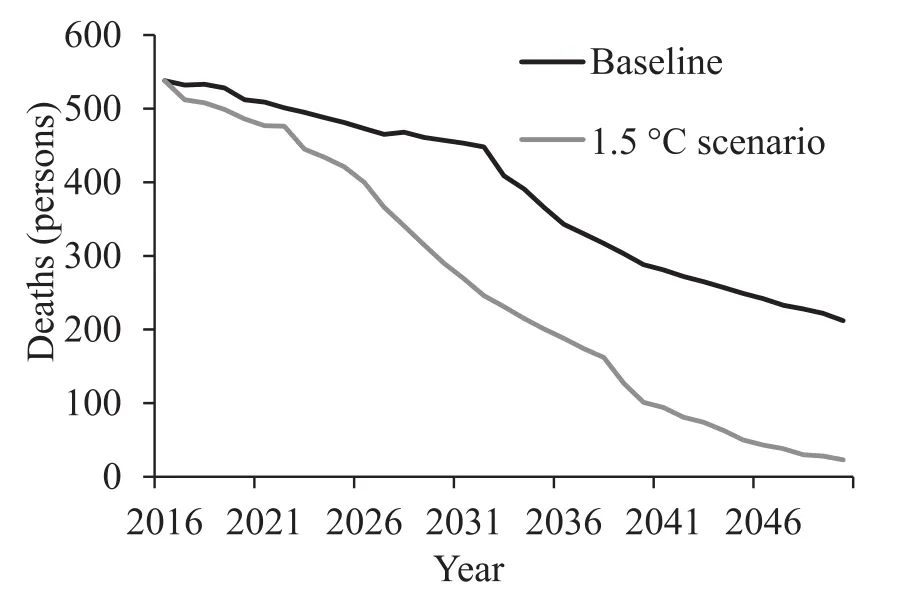
Fig.4.The number of deaths in the coal industry under the two scenarios in 2016-2050.
Under the baseline scenario,the number of employees with new occupational diseases in the coal industry declines.The largest number and ratio of employees with new occupational diseases in 2016 are 10,487 and 0.24%,respectively,which decreases to 617 and 0.05%in 2050,respectively.Likewise,under the 1.5°C scenario,the number of employees with new occupational diseases in the coal industry declines.The largest number and ratio of employees with new occupational diseases in 2016 are 10,487 and 0.24%,respectively,which decreases to 120 and 0.04%in 2050,respectively(Fig.5).
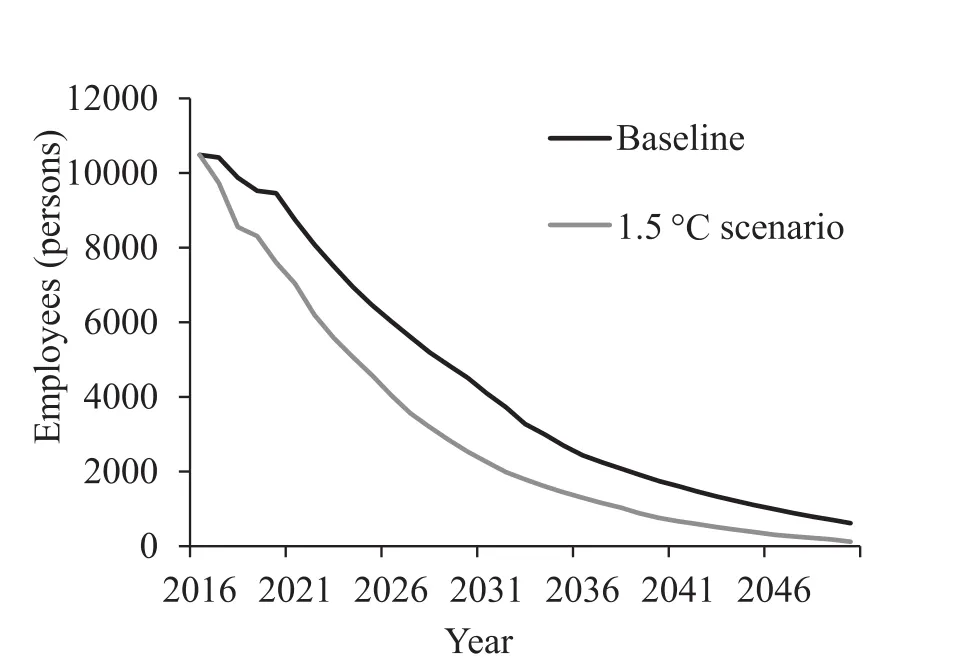
Fig.5.The number of employees with new occupational diseases in the coal industry under two scenarios in 2016-2050.
3.2.The monetary quantification of the effect
3.2.1.The monetary value of the effect
It is challenging to estimate the monetary value of all the effects of total coal regulation.Similar studies have adopted methods such as the cost method,shadow price method,human capital method,willingness-to-pay method,and travel cost method.The cost method calculates the cost of the acquiring factors(Li and Luo,2011).The shadow price method is“an opportunity cost of the input(such as capital,labor,and foreign exchange)or the loss of one unit of supply to the entire economy”(Fa,2015).The human capital method is generally used to measure the loss in human health caused by environmental pollution.It estimates the income loss because of the cost of premature retirement and death caused by thepollution(Shou,2017).According to themarginal labor productivity theory,the value of a person's loss of life or working time is equal to the value of the person's labor during this period,which is based on the present value of each person's future income according to the age,sex,and education degree.The willingness-to-pay method investigates the maximum amount of money that a person is willing to pay for something,such as better air and water,to measure the utility of such an item.The travel cost method estimates the amount of expenditure whenever a tourist travel as the price of travel,and the frequency as the demand for travel;it figures out the benefi ts of the travel destination through the regression analysisof resourcesof the travel demand function.Thismethod is widely used to estimate the value of biodiversity and other biological resources(Mao et al.,2008).
This study mainly uses the cost,human capital,and willingness-to-pay methods to monetarily quantify the effect of each demand.Considering the total coal amount control,the effect can be calculated as a unifi ed quantization effect(the analyses in this study consider only two scenarios for the effect quantization of the four indexes:the coal-mining mechanization,coal mine safety production level,worker health,and ecological environment damage)to compare the comprehensive effect of the total coal regulation under different scenarios,according to the shadow price of each factor.
(1)Technical progress
The monetary value of technological progress in the coal industry can be derived from the research and experimental development expenditureof other industries.In thisstudy,it is estimated using the cost method.
(2)Safety production level of coal mines
The cost of employee death caused by mining accidents consists of three parts:rescue cost,coal loss,and employee's remedial expenses(Su,2012).The cost of employee's remedial expenses is relatively easy to estimate.It can be referred to as the compensation regulations in the “rules”of industrial injury insurance.In this study,the compensation of each victim is estimated,and it includes the following three parts:the lump-sum payment of industrial death labor,funeral subsidy,and pension offered to dependents.
The funeral subsidy=the average annual wage of the workers in the district×6.
The lump-sum payment of industrial death labor=the national annual average salary of the employee×20.
The sum of pension offered to dependents is calculated according to the wages of the deceased worker.
In addition,coal-mining enterpriseswhich suffer from coalmining accidents have large economic losses.As the cost of the rescue and loss of the mine are diffi cult to estimate,in this study,the cost of the miners compensation is estimated by 2-3 times.
(3)The health level of the workers
The monetary price of new occupational diseases is based on the cost of occupational disease treatment.Because pneumoconiosis accounts for nearly 90%of occupational diseases reported in the coal industry,estimation is done using the cost of pneumoconiosis treatment.According to Yu and Li(2005),the direct economic loss caused by national annual pneumoconiosis has reached CN¥8 billion,and indirect losses amount to CN¥30 billion to CN¥40 billion.Somescholarsbelievethat there are more than 600,000 people with pneumoconiosis in China.Assuming the annual treatment cost of each pneumoconiosis case is CN¥40,000,the national direct economic loss is more than CN¥20 billion(Song and Li,2014).
In this study,factors such as economic growth are considered,so that the estimated cost of personal treatment for pneumoconiosis patients is about CN¥50,000 to 100,000.As for a 25-year treatment period for each pneumoconiosis patient,it is estimated to cost about CN¥1.25-2.5 million for a new patient.Meanwhile,the occupational patients have lost their ability to work and are burdened with a huge opportunity cost,which can add to the cost of unemployment(CN¥450,000-900,000 per capita).As a result,the cost of new occupational disease in the coal industry is about CN¥1.7-3.4 million.
(4)Environmental damage
According to the Research of True Cost of Coal by Tsinghua University and Environmental Planning Institute,Ministry of Environmental Protection,it is estimated that the environmental and health impact CN¥260 (tce)-1(Teng,2015).Among which the external damage cost of coal production is CN¥66.3(tce)-1,which accounts for about 25%;the external damage cost of coal transportation is CN¥27.8(tce)-1,which accounts about 11%;and the external damage cost of coal consumption is CN¥166(tce)-1,which accounts about 64%,considering the present technological condition of China's coal production,transportation,consumption,and governance situation.In this study,it is estimated that the ecological environment cost of coal mining is CN¥70(tce)-1.
(5)Loss of employment
Generally,the composition of unemployment can be divided into the personal cost and the social cost.The personal cost includes the opportunity cost of personal work income,the loss of personal capital during employmentpending or unemployment state,and the individual mental pressure.Social costs include the costs of social security,social assistance,and social instability because of unemployment.To simplify the estimation,the personal cost of unemployment in this study is the average wage of the workers in the coal industry multiplied by the average working years,and the social cost is half of the personal cost.The average salary in the coal industry is about CN¥60,000(Zhang,2016b).If the average unemployment period is 10 years,the average cost of unemployment is about CN¥600,000,and the social cost is CN¥300,000.Therefore,the loss of workers in the coal industry is about CN¥900,000 per capita.
Considering the economic growth,this study predicts the monetary value of all synergistic effect factors in the 1.5°C scenario from 2016 to 2050,as shown in Table 3.
3.2.2.The monetization of the effect
Table 3 and Section 3.1 can be used to monetize thevalue of the effects of coal regulation under the 1.5°C and baseline scenarios.The difference in the monetization values between the two scenarios is the net synergy of the 1.5°C scenario compared with the baseline scenario,as shown in Table 4.
Table 4 shows that before 2040,the comprehensive negative effect of the 1.5°C scenario is more than or equivalent to the positive effect,and the negative effect on employment is thegreatest which should bethefocus.Until 2050,thepositive effect of the 1.5°Cscenario isgreater than thenegativeeffect,which is most obvious on the ecological environment.The decrease of coal production will decrease the ecological environmental damage and signifi cantly improve the ecological environment.

Table 3 The monetary value of various factors(2016-2050).

Table 4 The net synergy of 1.5 °C scenario(billion CN¥).
4.Conclusions
In this study,using the three-stage least squares method to estimate the simultaneous equation model,and through the simultaneous equation model to calculate the 1.5°C scenario,coal production,coal science and technology progress,employment,safety in production level,and the worker health level of the five variables are predicted.
This study mainly uses the cost,human capital,and willingness-to-pay methods to monetarily quantify the effect of each demand.Considering thetotal coal amount control,the effect can be calculated as a unifi ed quantization effect.The results show that the positive effect values are safety production,health level and ecological environment,and only the negative effect value of employment.
The prediction of 1.5°C scenario promotes the increase of scientifi c production capacity and promotes the orderly development of coal.It has strengthened the safety and health protection degree,made the coal industry more efficient and competitive,and avoided or reduced the impact of coal development on the ecological environment and achieved environmental friendliness.However,the 1.5°C situation also increases the employment pressure of the society,which affects the economic development of the major coal producing areas,but the situation can be overcome through the transformation and upgrading of the region.In general,the positive effect of 1.5°C on the sustainable development of coal industry is greater than the negative effect.
5.Policy suggestions for the sustainable development of the coal industry
5.1.Innovation of new mechanism to support the resettlement of miners to guarantee harmony and stability of resource-dependent cities
The 1.5°C scenario will inevitably lead to the transfer of the coal industry and reduce employment,as several coal mineswill beshut down.Since thedevelopment of many coal cities or towns is closely linked to their resources,the shutdown will not only result in unemployment but will also directly affect the relevant industries that serve coal mines.The government needs to develop supporting policies for industrial transformation to ensure social stability.This study suggests that the government should introduce policies to promote the clean and efficient transformation of coal and establish integrated management systems for upstream and downstream industries. The government should also encourage the development of modern coal logistics industries to absorb more employment.In addition,the government should improve the subsidy methods of industrial transfer and broaden channels for resettlement.Compared with the direct subsidies given to the coal enterprises,subsidies to support industrial transformation will have better effect.
5.2.Construction of policy-guarantee mechanisms for clean and efficient coal utilization
The government should enhance support for technological research of clean and effi cient coal utilization and favorable fi scal and taxation policies.The government needs to promote industrial development by establishing policy-guarantee mechanisms and industrial standards and service systems and enhance personnel training and team integration.
5.3.Improving occupational health-related rules and regulations to elevate the occupational health of miners
The government should accelerate the implementation of industrial injury insurance and accidental insurance system and introduce commercial insurance into the coal industry.The social welfare that the miner working for 20 years within one coal mine can enjoy after retirement should be generalized.Supervision of labor safety should be strengthened to regulatebehaviors.The Occupational Diseases Prevention Act should be enforced for miners to simplify procedures of occupational diseases examination and ensure that the legal right and interests of miners are not violated.To lower the incidence of occupational diseases,labor intensity and working hours should be reduced.In addition,increasing investment in safety and mechanized productivity and improving the working environment areindispensableto occupational health.
Acknowledgments
The authors gratefully acknowledged the fi nancial support from the CCTEG Science and Technology Innovation Fund(2018MS040).
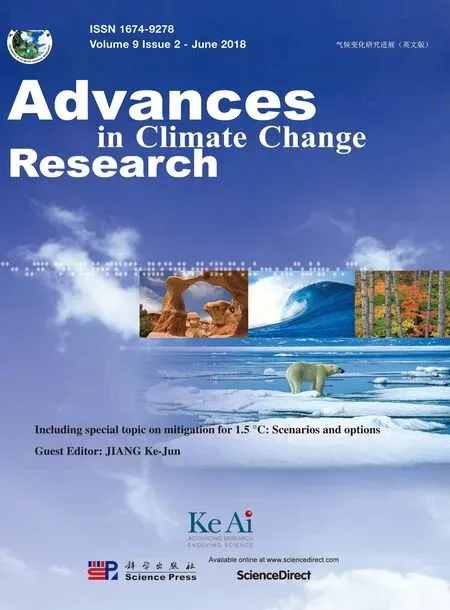 Advances in Climate Change Research2018年2期
Advances in Climate Change Research2018年2期
- Advances in Climate Change Research的其它文章
- 1.5°C target:Not a hopeless imagination
- Impact of and adaptation strategiesfor sea-level rise on Yangtze River Delta
- Development path of Chinese low-carbon cities based on index evaluation
- China's nuclear power under the global 1.5°Ctarget:Preliminary feasibility study and prospects
- Changes in temperature extremes over China under 1.5 °C and 2 °C global warming targets
- Changes in surface air temperature over China under the 1.5 and 2.0°C global warming targets
